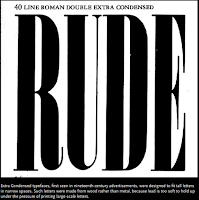As I absentmindedly perused my
social media feed (a typical Sund... every day (who am I kidding?) routine), I
came across the cutest post entitled "Cats as Fonts." As if this post
were after my very heartstrings, I scrolled through the adorable pictures of
kittens dressed ridiculously to embody the attitude around common types or
fonts. For the average person, fonts are only knowingly interacted with through a Microsoft
Office product lens. Academic papers and reports are written in Times New Roman. Sensible
emails are sent in Arial or Tahoma.
All
Microsoft Office applications default to Calibri. And that seems to be okay, as the average
person is more focused on their message--what it is they want to convey--than
how that message is presented. But unknowingly, we directly encounter fonts everywhere, in ways we'd never imagine.

 Since the 1940s, the
significance of font has been debated and engendered for the purpose of
advertising. An obsession formed around how the look of a thing could influence
people, and make them say… want to buy a product. As time marched ahead, in the
interest of technology and progress, consumerism became less about selling a single
product and more about selling an idea. Brand recognition and product loyalty
are what companies are after today, and they are using visual imagery to draw
us in. Advertisers are also thinking
about what fonts to use.
Since the 1940s, the
significance of font has been debated and engendered for the purpose of
advertising. An obsession formed around how the look of a thing could influence
people, and make them say… want to buy a product. As time marched ahead, in the
interest of technology and progress, consumerism became less about selling a single
product and more about selling an idea. Brand recognition and product loyalty
are what companies are after today, and they are using visual imagery to draw
us in. Advertisers are also thinking
about what fonts to use.
Gary Hustwit created a two hour
documentary about the history, future, and nuances of the font he termed “ubiquitous,”
Helvetica. The personification assigned to these fonts is interesting in the sense
that--behind certain closed doors--a power to express attitudes through fonts that the unconscionable reader does not recognize is being manipulated. If fonts are the nonverbal
communication of written text, just what are they saying?
 Ted Hunt, in an article posted
on The Daily Egg, talks about the
psychology behind choosing typeface in order to solicit a certain emotional or
psychological reaction from an audience. He says in his article,
Ted Hunt, in an article posted
on The Daily Egg, talks about the
psychology behind choosing typeface in order to solicit a certain emotional or
psychological reaction from an audience. He says in his article,
“You should take
careful consideration when choosing a logo font. As you may already know,
people have certain feelings, emotions, and associations when they see certain
colors. What you may not realize is that they have a similar response to
typefaces and fonts.”
The article then goes on to
explain the perceptions of several of the more successful font styles in
advertising (seen below);
 |
| Ted Hunt in "A Pro Designer Shares the Psychology of Font Choices" |
It is interesting to see how
something so easily taken for granted by one group of people is a highly
prioritized consideration for another group of people. Remember that the next
time you’re writing a persuasive argument for a class or when you’re
constructing an email to ask your boss for a raise. It’s not just the content
of your message that might help sell your point. Oh yeah, about those cats...
























